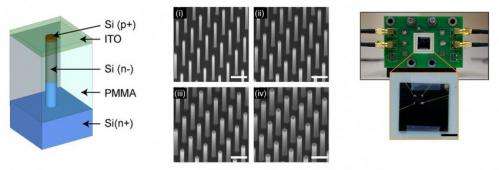Color image of test objects taken by the nanowire-based photodetector. Credit: Park, et al. ©2014 American Chemical Society
(Phys.org) —Most of today's digital cameras achieve color by using red, green, and blue Bayer color filters through which light passes on its way to the camera's image sensors, which then convert the light into electrical signals. Although this color filter technology is very widespread, it has some disadvantages related to durability, low absorption coefficient, and fabrication complexity. In addition, the absorbed light in the color filter cannot be converted into photocurrent. To maximize the efficiency in the trends of higher pixel density, this light needs to be converted to photocurrent.
In the past few years, researchers have been investigating new ways to achieve color in digital cameras that don't rely on conventional organic dye filters. In a new paper published in Nano Letters, a team of researchers from Harvard University in Cambridge, Massachusetts, and Zena Technologies Inc., in Topsfield, Massachusetts, have presented a new filter-free approach to color imaging. The technique uses silicon nanowires with different radii to absorb specific wavelengths, and thus colors, of light and convert the light into photocurrent.
"Our nanowire-based approach performs color imaging without conventional color filters," coauthor Kenneth B. Crozier of Harvard University told Phys.org. "This has two major advantages. First, our approach simplifies the fabrication process. Nanowire-based image sensor pixels with different color responses can be defined at the same time through a single lithography step. This means no additional materials or repeated deposition steps are needed for separating colors. Second, our approach opens the way to increase the efficiency of an image sensor. Each nanowire captures light of a specific color, and converts it to photocurrent. If we add substrate photodetector, we can capture the remainder of the spectrum. In this way, the image sensor can have higher efficiency, as photons would be not discarded by absorptive filters."
(Left) Schematic of photodetectors based on vertical silicon nanowires. (Center) Magnified view of nanowires with radii of 80 nm, 100 nm, 120 nm, and 140 nm. (Right) Fabricated device mounted on PCB, with a magnified image in the inset. Credit: Park, et al. ©2014 American Chemical Society
The new approach takes advantage of the unique optical and electrical properties of one-dimensional semiconductor nanowires. Previous research has demonstrated that silicon nanowires absorb wavelengths of light that vary with the nanowire radius, allowing for control of light absorption by fabricating nanowires with controlled radii using a single lithography step. However, no color imaging experiments have been performed with silicon nanowires until now, partly due to the difficulty in assembling large numbers of nanowires into arrays.
In the new study, the researchers successfully fabricated 100 x 100 arrays of vertical nanowires with radii of 80, 100, 120, and 140 nm, allowing the nanowires to absorb different wavelengths of light. The researchers demonstrated that these nanowire-based photodetectors can photograph color images of test scenes and the Macbeth ColorChecker card with a quality that is very similar to that obtained with a conventional camera.
The new filter-free color imaging technique has some key advantages compared with the conventional filter technique, with perhaps the most important being a higher absorption efficiency that allows for higher pixel densities and higher resolution. The researchers predict that adding a bottom photodetector to the nanowire array would make it possible, in principle, for the device to absorb all incoming light and convert it into photocurrent. Such a device has the potential for extremely high photon efficiencies compared to filter-based devices, which by their nature absorb approximately half of the incoming light before it reaches the image sensor. The greater efficiency would then pave the way for cameras with higher resolutions. In addition to an improved efficiency, this approach simplifies the fabrication process. As the researchers explain, the pixels with different color responses can be defined at the same time through a single lithography step.
Furthermore, the nanowire-based photodetectors also offer the opportunity for multispectral imaging. Cameras use multispectral imaging to capture light at different frequencies of the spectrum, including frequencies beyond the visible light range. With the new method, different parts of the spectrum can be targeted for absorption by fabricating nanowires with specific radii, a relatively simple process compared to fabricating filters and other methods. The researchers plan to work on further improving the photodetectors in the future.
"We are currently working on incorporating substrate photodetectors to increase the efficiency as we mentioned above," said coauthor Hyunsung Park at Harvard University. "In addition, we are developing elliptical nanowire-based photodetectors for polarization-resolved imaging. The major hurdle for commercialization is the higher dark current level of these devices, due to the fact they are produced by etching. This comes from the fact that there are many surface states, due to the large surface-to-volume ratio of the nanowires and damage to the silicon crystal structure from dry etching. We believe that this will be resolved in the future through alternative fabrication process or by adding passivation layers."
More information: Hyunsung Park, et al. "Filter-Free Image Sensor Pixels Comprising Silicon Nanowires with Selective Color Absorption." Nano Letters. DOI: 10.1021/nl404379w
Journal information: Nano Letters
© 2014 Phys.org. All rights reserved.
























